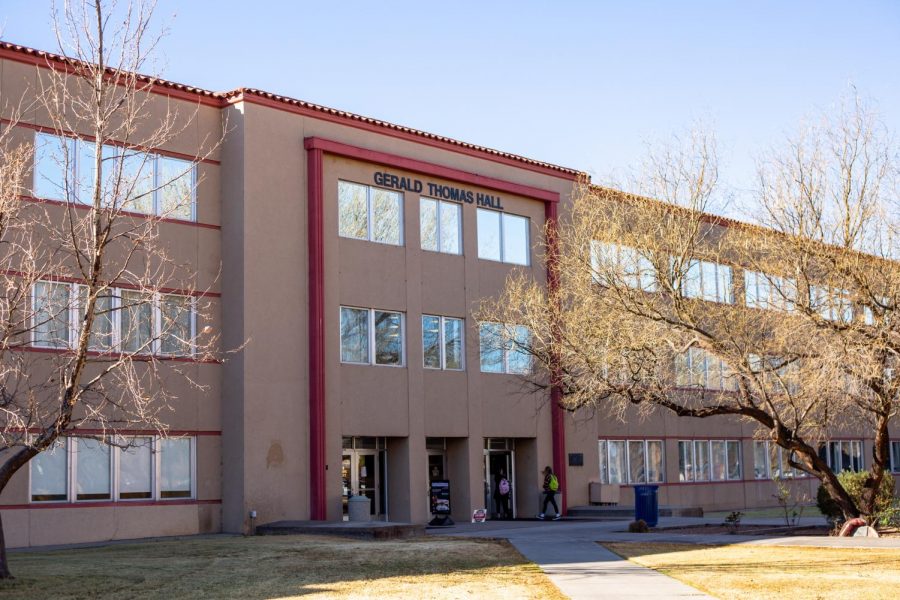NMSU’s Chile Pepper Institute to possibly develops chile peppers for NASA

More stories from Marianne Salas
The Chile Pepper Institute is located within the College of Agricultural, Consumer and Environmental Sciences.
New Mexico State University’s Chile Pepper Institute may soon be exploring new heights. The Chile Pepper Institute, located within the College of Agricultural, Consumer and Environmental Sciences, has recently been contacted by the National Aeronautics and Space Administration to develop a chile pepper plant suitable for a mission to Mars.
The Chile Pepper Institute was first established in 1992 and is the only international, non-profit organization to specialize in the research and development of chile peppers.
The director of the Chile Pepper Institute, Paul Bosland Ph.D., is renowned for his research in chile breeding and genetics.
Bosland said one day a representative from NASA called and informed him that they were in the beginning stages of planning an expedition to Mars. One of the issues that NASA scientists were facing was Vitamin C levels deteriorating on the trip itself, a 3 year voyage to Mars and back.
“The representative told us that they knew that chile peppers are very high in Vitamin C and were wondering if they could grow peppers on the spaceship to act as a source of Vitamin C,” Bosland said.
NASA requested the production of a dwarf chile pepper plant that could survive under low light and pressure levels. Bosland compared the air pressure of space to an elevation level of 9,000 feet on Earth.
Another requirement of the proposed chile pepper plant was that it could not produce heat or pollen due to possible irritation. Most importantly, the chile pepper plant would have to continually produce fruit with a high Vitamin-C content.
“The issue is that it takes about ten years from the time we make our first hybridization to when we have a finished product. I always like to tell people that plant breeders are both artists and scientists. We’re like a painter with a palette of colors except that we have a palette of genes that we have to put together in order to get the finished product,” Bosland said.
Bosland outlined several goals for the project, one simply being to have a finished product that meets the criteria set forth by NASA. Another goal is bringing positive public relations to NMSU, as well as being recognized and viewed on the same level as other prominent universities in the United States.
Bosland said when he first came to NMSU 33 years ago, New Mexico was no better or worse than Arizona or Texas in terms of chile production.
“But now, through hard work over these years, we’ve established ourselves as the chile pepper capital of the world. It’s even on our license plates now,” Bosland said.
At the time of Bosland’s arrival, consumers wanted New Mexico green chile seeds but could not find a reliable seller to purchase them from One of the first goals of the Chile Pepper Institute was to provide a facility where people could obtain chile pepper seeds. Now, the Chile Pepper Institute has dedicated itself to educating the world about chile peppers.
The chile pepper first originated in modern-day Bolivia and spread across South America through bird migration patterns. The Chile pepper’s hotness is considered a defense mechanism in order to ware off small mammals from consuming the fruit. Chile pepper plants cross-pollinate well, allowing for thousands of variations in genetic composition.
The Chile Pepper Institute centers its research on five basic types of chile peppers: the jalapeño, cayenne pepper, green and red New Mexican pod types and paprika, a red New Mexican pod type without heat.
The New Mexican pod type resembles a jalapeño in its form and was developed at NMSU by Fabian Garcia, the university’s first horticulturist and a member of the very first graduating class in 1894.
The Chile Pepper Institute’s Visitor’s Center and Gift Shop is located in Gerald Thomas Hall, room 265 and is open Monday through Friday from 8 a.m. to 5 p.m. The Chile Pepper Institute Garden, located on 113 West University Avenue, will be open from July to October 2019. Those interested in learning more about the Chile Pepper Institute or wishing to place an order can visit the Chile Pepper Institute’s website at https://www.cpi.nmsu.edu.

Marianne Salas is a senior at NMSU pursuing a double-major in English and Government with a supplementary major in Law & Society. She will be attending...

